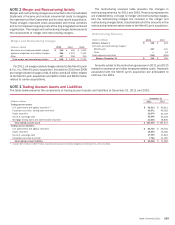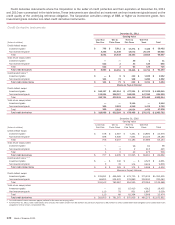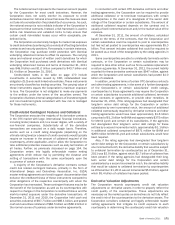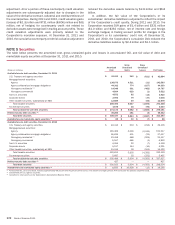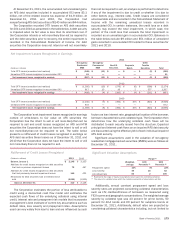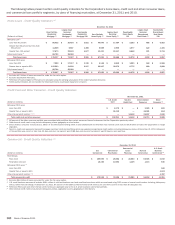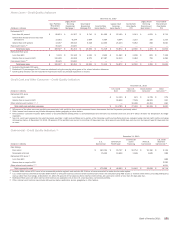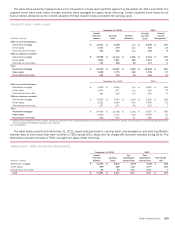Bank of America 2011 Annual Report Download - page 175
Download and view the complete annual report
Please find page 175 of the 2011 Bank of America annual report below. You can navigate through the pages in the report by either clicking on the pages listed below, or by using the keyword search tool below to find specific information within the annual report.
Bank of America 2011 173
At December 31, 2011, the accumulated net unrealized gains
on AFS debt securities included in accumulated OCI were $3.1
billion, net of the related income tax expense of $1.9 billion. At
December 31, 2011 and 2010, the Corporation had
nonperforming AFS debt securities of $140 million and $44 million.
The Corporation recorded OTTI losses on AFS debt securities
for 2011 and 2010 as presented in the table below. A debt security
is impaired when its fair value is less than its amortized cost. If
the Corporation intends or will more-likely-than-not be required to
sell the debt securities prior to recovery, the entire impairment is
recorded in the Consolidated Statement of Income. For debt
securities the Corporation does not intend or will not more-likely-
than-not be required to sell, an analysis is performed to determine
if any of the impairment is due to credit or whether it is due to
other factors (e.g., interest rate). Credit losses are considered
unrecoverable and are recorded in the Consolidated Statement of
Income with the remaining unrealized losses recorded in
accumulated OCI. In certain instances, the credit loss on a debt
security may exceed the total impairment, in which case, the
portion of the credit loss that exceeds the total impairment is
recorded as an unrealized gain in accumulated OCI. Balances in
the table below exclude $9 million and $51 million of unrealized
gains recorded in accumulated OCI related to these securities for
2011 and 2010.
Net Impairment Losses Recognized in Earnings
(Dollars in millions)
Total OTTI losses (unrealized and realized)
Unrealized OTTI losses recognized in accumulated OCI
Net impairment losses recognized in earnings
Total OTTI losses (unrealized and realized)
Unrealized OTTI losses recognized in accumulated OCI
Net impairment losses recognized in earnings
Total OTTI losses (unrealized and realized)
Unrealized OTTI losses recognized in accumulated OCI
Net impairment losses recognized in earnings
2011
Non-agency
Residential
MBS
$ (348)
61
$ (287)
2010
$ (1,305)
817
$ (488)
2009
$ (2,240)
672
$ (1,568)
Non-agency
Commercial
MBS
$ (10)
—
$ (10)
$ (19)
15
$(4)
$(6)
—
$(6)
Non-U.S.
Securities
$—
—
$—
$ (276)
16
$ (260)
$ (360)
—
$ (360)
Corporate
Bonds
$—
—
$—
$(6)
2
$(4)
$ (87)
—
$ (87)
Other
Taxable
Securities
$(2)
—
$(2)
$ (568)
357
$ (211)
$ (815)
—
$ (815)
Total
$ (360)
61
$ (299)
$ (2,174)
1,207
$ (967)
$ (3,508)
672
$ (2,836)
The Corporation’s net impairment losses recognized in earnings
consist of write-downs to fair value on AFS securities the
Corporation has the intent to sell or will more-likely-than-not be
required to sell and credit losses recognized on AFS and HTM
securities the Corporation does not have the intent to sell or will
not more-likely-than-not be required to sell. The table below
presents a rollforward of credit losses recognized in earnings on
AFS debt securities these losses as of December 31, 2011 and
2010 that the Corporation does not have the intent to sell or will
not more-likely-than-not be required to sell.
Rollforward of Credit Losses Recognized
(Dollars in millions)
Balance, January 1
Additions for credit losses recognized on debt securities
that had no previous impairment losses
Additions for credit losses recognized on debt securities
that had previously incurred impairment losses
Reductions for debt securities sold or intended to be
sold
Balance, December 31
2011
$ 2,148
72
149
(2,059)
$ 310
2010
$ 3,155
487
421
(1,915)
$ 2,148
The Corporation estimates the portion of loss attributable to
credit using a discounted cash flow model and estimates the
expected cash flows of the underlying collateral using internal
credit, interest rate and prepayment risk models that incorporate
management’s best estimate of current key assumptions such as
default rates, loss severity and prepayment rates. Assumptions
used can vary widely from loan to loan and are influenced by such
factors as loan interest rate, geographical location of the borrower,
borrower characteristics and collateral type. The Corporation then
determines how the underlying collateral cash flows will be
distributed to each security issued from the structure. Expected
principal and interest cash flows on an impaired AFS debt security
are discounted using the effective yield of each individual impaired
AFS debt security.
Significant assumptions used in the valuation of non-agency
residential mortgage-backed securities (RMBS) were as follows at
December 31, 2011.
Significant Valuation Assumptions
Prepayment speed
Loss severity
Life default rate
Weighted-
average
10%
49
50
Range (1)
10th
Percentile (2)
3%
15
2
90th
Percentile (2)
22%
62
100
(1) Represents the range of inputs/assumptions based upon the underlying collateral.
(2) The value of a variable below which the indicated percentile of observations will fall.
Additionally, annual constant prepayment speed and loss
severity rates are projected considering collateral characteristics
such as LTV, creditworthiness of borrowers as measured using
FICO scores and geographic concentrations. The weighted-average
severity by collateral type was 43 percent for prime bonds, 50
percent for Alt-A bonds and 60 percent for subprime bonds at
December 31, 2011. Additionally, default rates are projected by
considering collateral characteristics including, but not limited to


